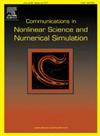凸凹鞍点问题的原对偶新算法
IF 3.8
2区 数学
Q1 MATHEMATICS, APPLIED
Communications in Nonlinear Science and Numerical Simulation
Pub Date : 2025-09-27
DOI:10.1016/j.cnsns.2025.109377
引用次数: 0
摘要
原始对偶算法(PDA)是求解凸凹鞍点问题的一种经典而流行的算法。人们普遍认为,原始变量和对偶变量的子问题中的近邻项对原始-对偶算法的收敛理论和数值性能至关重要。通过利用当前和先前迭代点的信息,我们在所有先前生成的迭代点上使用两个凸组合,为原变量和对偶变量的子问题生成两个新的近端项。值得注意的是,赋给最近迭代点的权值总是显著的,下界为0.75,无论凸系数是接近0还是接近1。基于两个新的近端项,提出了一种新的具有双线性耦合项的凸凹鞍点问题的原对偶算法,并证明了该算法的全局收敛性和O(1/N)遍历收敛速率。当原函数或对偶函数均为强凸时,我们加速了上述算法,并证明了相应的算法可以达到O(1/N2)的收敛速度。由于所提算法的步长条件与线性变换的谱范数直接相关,这在某些应用中很难得到,我们还对所提的原对偶算法引入了一种线性研究策略,并建立了其全局收敛性和O(1/N)遍历收敛速率。通过与其他算法的比较,对矩阵博弈和LASSO问题进行了数值实验,验证了本文提出的三种原对偶算法的有效性。本文章由计算机程序翻译,如有差异,请以英文原文为准。
New primal-dual algorithm for convex-concave saddle point problems
Primal-dual algorithm (PDA) is a classic and popular scheme for convex-concave saddle point problems. It is universally acknowledged that the proximal terms in the subproblems of the primal and dual variables are crucial to the convergence theory and numerical performance of primal-dual algorithms. By taking advantage of the information from the current and previous iterative points, we employ two convex combinations on all previously generated iterative points to generate two new proximal terms for the subproblems of the primal and dual variables. It is remarkable that the weight assigned to the latest iterative point is always significant with a lower bound of 0.75 and can approach 1 regardless of whether the convex coefficient is near 0 or 1. Based on two novel proximal terms, we present a new primal-dual algorithm for convex-concave saddle point problems with bilinear coupling term and establish its global convergence and an O ( 1 / N ) O ( 1 / N 2 ) O ( 1 / N )
求助全文
通过发布文献求助,成功后即可免费获取论文全文。
去求助
来源期刊

Communications in Nonlinear Science and Numerical Simulation
MATHEMATICS, APPLIED-MATHEMATICS, INTERDISCIPLINARY APPLICATIONS
CiteScore
6.80
自引率
7.70%
发文量
378
审稿时长
78 days
期刊介绍:
The journal publishes original research findings on experimental observation, mathematical modeling, theoretical analysis and numerical simulation, for more accurate description, better prediction or novel application, of nonlinear phenomena in science and engineering. It offers a venue for researchers to make rapid exchange of ideas and techniques in nonlinear science and complexity.
The submission of manuscripts with cross-disciplinary approaches in nonlinear science and complexity is particularly encouraged.
Topics of interest:
Nonlinear differential or delay equations, Lie group analysis and asymptotic methods, Discontinuous systems, Fractals, Fractional calculus and dynamics, Nonlinear effects in quantum mechanics, Nonlinear stochastic processes, Experimental nonlinear science, Time-series and signal analysis, Computational methods and simulations in nonlinear science and engineering, Control of dynamical systems, Synchronization, Lyapunov analysis, High-dimensional chaos and turbulence, Chaos in Hamiltonian systems, Integrable systems and solitons, Collective behavior in many-body systems, Biological physics and networks, Nonlinear mechanical systems, Complex systems and complexity.
No length limitation for contributions is set, but only concisely written manuscripts are published. Brief papers are published on the basis of Rapid Communications. Discussions of previously published papers are welcome.
 求助内容:
求助内容: 应助结果提醒方式:
应助结果提醒方式:


